| THE ING NEWSLETTER | No. 3, September 2000 |
|
|
SCIENCE |
|
|
|
| Previous: | WHT Measures Speed of Surface Vibrations on Stellar Corpses | Up: | Table of Contents | Next: | Lithium Trail Leads Back to the Big Bang |
Other available formats: PDF | gzipped Postscript
Now You See It
and Now You Don't !
Comet LINEAR
Blows Up in Full View of the JKT
Mark Kidger (Instituto de Astrofísica de Canarias)
It's quite something to be able to observe regularly at somewhere like the Roque de los Muchachos Observatory. As a schoolboy I had visited the Isaac Newton Telescope at Herstmonceux no less than four times, before it was moved to La Palma. During these visits had dreamed of one day using it and, when I finally did, in 1985, it was to observe Comet Halley, which was something very special for me.
When I was assigned the time in La Palma on the JKT, I gave thanks for my extraordinary luck that the observations (a programme of quasar microvariability observations) were scheduled exactly at the perihelion of Comet LINEAR, or C/1999 S4 (LINEAR) as it is correctly known. This would be able to get data on the comet at the start of each night without interrupting the main programme. At the time I hoped that Comet LINEAR might become a reasonable spectacle. Never did I imagine that I would have a front seat for an amazing spectacle —but not the one that I had expected.
There has been something odd about Comet LINEAR right from the start. Comet LINEAR really is a first-time object from the Oort Cloud, despite the fact that the latest orbit from the Minor Planet Center seems to show it in a strongly closed orbit. In fact, it has fallen in from about 1 light year out, well into the outer part of the cloud. However, it has never behaved like a new comet. One expects an object like Comet LINEAR to be extremely gassy and brighten fast at large heliocentric distance, something that it did not do. In fact, apart from a short period before perihelion the brightening rate was always below average. According to HST observations taken three weeks before perihelion, the comet has very unusual composition. Rather than 80% water ice and about 10% CO ice, the proportion of CO ice is about 20 times lower, which explains the slow brightening at large distances from the Sun, as CO is the dominant volatile at these distances. The comet thus brightened only very slowly initially.
Again, although only the HST observations have been widely published, it seems that small fragments have been expelled from the nucleus for some months. Had this been more widely known it might have been realised that this comet was an extraordinarily fragile body compared to most comets. This made the comet a candidate to break-up at perihelion, the moment when the insolation is not just much greater, but also changes direction very rapidly, causing enormous thermal stresses on the comet's nucleus.
On July 23rd, the first night of the JKT run, the comet was in the throes of a minor outburst, and had reached magnitude 6, and was showing a quite spectacular tail. The JKT's CCD has a field of view of some 11 arcminutes and even in the short exposures that the comet's rapid motion allowed, the streamers flowed across the diagonal of the chip and out of the field, being at least 15 minutes long. In fact, the comet was so bright and condensed that observing it was a real problem. It saturated badly in a 5-second exposure. In the end, exposures of just 2 seconds with the R (red) filter were required.
On July 24th, a German astronomer visiting the Roque asked permission to visit the telescope with his girlfriend during the observations. I prepared to show them a spectacular comet. To my enormous chagrin, there was almost no tail to be seen. Much longer exposures could also be taken without getting near saturating. At the time the alarm bell did not ring, but it should have done.
On July 25th things started badly. There was a power failure shortly before sunset and all the computers went down. A lot of ING staff battled to get the systems up again. At 9:30 pm the control system was still not working and the observations were in great danger of not being made. Shortly afterwards, despite network problems and a slow system response, the TCS and ICS could be brought up, although with some missing tasks. In fact, it was not until 11:15 pm that everything was truly up and running again, by which time the comet would have set on the telescope. Thanks though to the efforts of Peter van der Velde and other, anonymous staff, and the advice of Neil O'Mahoney on the INT, the critical observations of the comet were saved.
To avoid wasting valuable time the comet was positioned on the chip as soon as it was too late to take flat fields. Even the very first images, with the sky half way to saturating the CCD, were enough to show that something odd was going on. The comet's inner coma was no longer teardrop shaped (the solar wind flowing around the comet's head causes this shape). In fact, the comet looked rhomboidal. As the sky darkened, it became clear that the innermost coma had a shape like a short, fat cigar.
My first thought was "Shoemaker-Levy". It looked just like those first images of Comet Shoemaker-Levy 9 after it was discovered. Now this kind of thing happens so rarely that my second thought was "too much imagination ! Shut up or you'll make a fool of yourself !". I passed the images to Brian Marsden (an old and very respected friend) and waited for a reaction, with a copy to the CometLinear.com website, adding a "PS" saying that it looked like the comet was breaking up. Caution though caused me to ask for that comment not to be used in the Web. Next day I also discussed the observations with Javier Licandro, my Ph.D., who was planning to observe the comet that night in the infrared on the TNG. Neither Brian, nor Javier were impressed.
"Maybe I am getting excited about nothing", I thought. Both commented that the comet had been expelling small fragments and that this was probably just another such event. That night though, July 26th, would be decisive. If it was a fragment, it should be clearly visible, separated from the nucleus. If it was a fragmentation, then there should be a "string of pearls" effect, as in Shoemaker-Levy 9.
With some excitement, the telescope was pointed again as dusk fell. Was it all a mistake? Would the comet look normal again? The first very ghostly images showed that the comet was even more elongated than previously. All kinds of contour maps and 3-D surface maps were tried, looking for sub-nuclei, but none could be seen. At this point I was convinced that the comet had fragmented. But would anyone else be? I sent the images off to Brian again but, very unusually, did not get a response —in fact because the Minor Planet Center was preparing its latest batch of Minor Planet Circulars and absolutely swamped with work !
Estimating the size of the "cigar" I was able to get an idea of its expansion velocity —about 40m/s. This is so slow that the cloud had to be of fairly heavy fragments of solid matter. In contrast, gas would expand perhaps as much as 50 times faster. It also led to the rather disconcerting conclusion that the break-up must have happened the previous evening —if only the comet could have been followed for a couple of hours before it set...
Once again, on the 27th, the telescope was swung to the comet during dusk in high expectation. Javier was now convinced that something very odd was happening and we made bets at dinner what it might be. By then I was convinced that the comet had completely broken up. We even speculated whether or not it would still be there to observe. It was, but even more extended and now much fainter. Several local amateurs sent in magnitude estimates suggesting that the comet had faded suddenly and was now a lot less condensed. This was consistent with a dying comet.
The elongation of the comet was
increasing at a steady rate and there was still no hint of the string of
pearls. This was it ! After seeing two or three images come down from the
camera I called Brian at his office and described what I was seeing. "I
guessed that it might be you", he said. Brian pointed out that Comet Bennett,
in 1974, had broken up in much the same way and added, encouragingly, "it's
time that we put something out on this. Send something in, but don't stop
observing". To avoid distractions, a long sequence of observations was
programmed into the computer in several filters so that the only intervention
required would be to re-centre the comet in the field occasionally as it
moved.
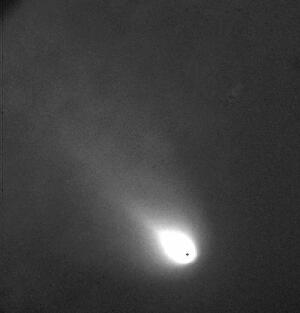 |
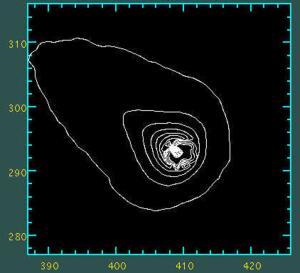 |
| Figure 1. JKT R-band image of Comet LINEAR on 23rd July. The central condensation showed the typical 'teardrop' form. [ JPEG | TIFF ] | Figure 2. Contour levels of the comet's coma on 23rd July. [ JPEG | TIFF ] |
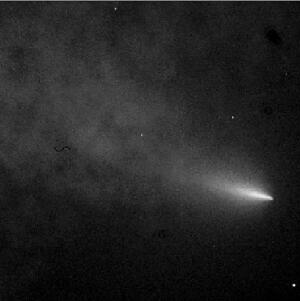 |
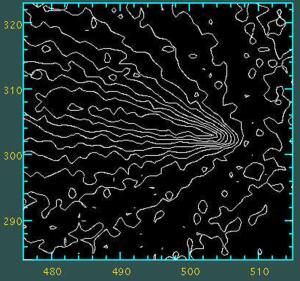 |
| Figure 3. Raw JKT R-band image of Comet LINEAR on 26th July. The central condensation is now strongly elongated, with a very flat brightness distribution. Coma's brightness had also faded and its length increased. [ JPEG | TIFF ] | Figure 4. Contour levels of the comet's coma on 26th July. The unusual elongated shape was the first evidence of the comet's complete break-up. [ JPEG | TIFF ] |
Being cynical about such things and worried about being scooped, I prepared a note for the IAU Circulars with all haste. Within an hour, mostly taken up with resending the text twice because it arrived unreadable, the circular was out. Although a set of radio observations of the comet received top billing on that particular circular, the data was out and the JKT had beaten a lot of bigger and more costly telescopes to the draw.
Some astronomers were sceptical initially, but the following day confirmatory observations were published from three groups (Filipenko, Nakano & Javier Licandro's TNG observations). Images and e-mails came in from all around the world. An American amateur called Jim Vail had observed the initial stages of the break-up without recognising it; Ian Griffen in New Zealand obtained a wonderful confirmatory image. Since then the comet has faded dramatically. Visually, it dropped three magnitudes in about 5 nights and, in the JKT images, the inner core has got bigger and bigger and its surface brightness has dropped constantly until it barely registered in a 20 second JKT exposure in B or Z on the 31st.
Service observations of the Comet
on August 1st proved scientifically very important indeed. With some American
astronomers still doubting that the comet had even been disrupted and making
highly negative statements to the press about the ING data, Romano Corradi
and Neil O'Mahoney were able to take deep exposures of the comet with the
Wide Field Camera on the INT. These were difficult observations with the
comet low in twilight, but were deep enough to show that no large fragments
of the nucleus had survived.
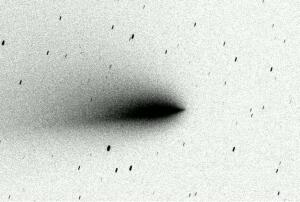 |
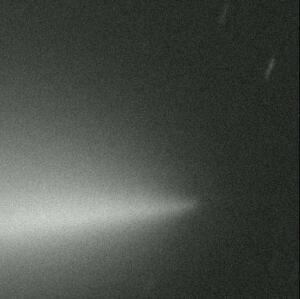 |
| Figure 5. This image, obtained on 1 August with the WFC on the INT, covers a field of view of 22 arcminutes and is processed to show the faint tail of the comet, which extends well beyond the edge of the field of view. [ JPEG | TIFF ] | Figure 6. This another image, obtained on 1 August, is a 100-second exposure with the WFC on the INT. This section of the full image measures 4.5 arcminutes, equivalent to 110,000 km at the comet. This image is processed to show faint details in the coma of the comet. No features are seen in the image, which implied that no significant individual fragments more than a few metres across still emit gas. This demonstrates the catastrophic disruption of the nucleus. [ JPEG | TIFF ] |
With a 5-sigma limiting magnitude of R=22.0, B=22.7, the absolute magnitude of the fragments could be no brighter than H=25. For icy fragments that are outgassing strongly the limiting size is just a few metres. Totally iceless fragments could be much larger as large as a few hundred metres in diameter, although the existence of such inactive fragments would suggest strongly that the death of the comet was due to exhaustion of volatiles.
The JKT and INT observations did however demonstrate that active fragments of some size had to exist given that the comet maintained a very sharp "spear-point" shape. It was thus evident that faint and unresolved fragments continued existing at this tip. This prediction was announced on IAUC 7474 and confirmed when the HST took a very deep integration of this area of the comet's head finding a number of faint cometessimals, the brightest of which was about 2 magnitudes fainter than the INT limiting magnitude. Further images with the VLT showed that there were at least a dozen detectable nuclei, although all of them were very faint indeed and unreachable to existing northern hemisphere telescopes.
This has been one of the very
few occasions when the break-up of a comet has been followed in such detail.
The results show that the nucleus, at least of Comet LINEAR, is far more
fragile than had been suspected. This holds enormous implications for future
space missions such as Deep Impact, which plans to launch a penetrator
at the nucleus of 9P/Tempel 1. Already people had feared that the nucleus
might not have the solidity to stop the penetrator, which could simply
go straight through and come out the other side. Comet LINEAR will do little
to calm such fears, even if it is probable that this was a particularly
fragile object.
Email contact: Mark Kidger (mrk@ll.iac.es)
| Previous: | WHT Measures Speed of Surface Vibrations on Stellar Corpses | Up: | Table of Contents | Next: | Lithium Trail Leads Back to the Big Bang |
| GENERAL | SCIENCE | TELESCOPES AND INSTRUMENTATION | OTHER NEWS FROM ING | TELESCOPE TIME |